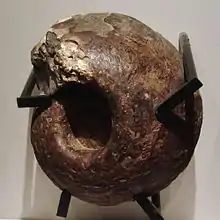Vascoceratidae
The Vascocertidae is a family of Upper Cretaceous ammonites in the superfamily Acanthoceratoidea characterized by shells that are either smooth or bluntly tuberculate, or have sparse, coarse ribs. Sutural elements are shallow, irregular, and slightly indented, or deep and very indented. Whorl section and degree of involution vary, even within species.
| Vascoceratidae Temporal range: U Cretaceous (l-m Turonian) | |
|---|---|
 | |
| Fossil of Fagesia spheroidalis from Japan. Late Cretaceous. Exhibit in the National Museum of Nature and Science, Tokyo, Japan. | |
| Scientific classification | |
| Kingdom: | Animalia |
| Phylum: | Mollusca |
| Class: | Cephalopoda |
| Subclass: | †Ammonoidea |
| Order: | †Ammonitida |
| Superfamily: | †Acanthoceratoidea |
| Family: | †Vascoceratidae Spath, 1925 |
The Vascoceratidae is a short lived family restricted to the early and middle Turonian stage. Its duration, no more than a few million years. They are derived from the Acanthoceratidae and are the predecessors of the Tissotiidae, which in turn gave rise to the Coilopoceratidae; all taking place in a short time span in the Turonian.
This article is issued from Wikipedia. The text is licensed under Creative Commons - Attribution - Sharealike. Additional terms may apply for the media files.